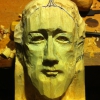So many carving tools to confuse and attract. But why? In this lesson I'll show you!

| 29 June 2022 07:57
Michael - Thanks for your thoughts and questions!
Regarding more chisel/gouge commentary, I'll certainly bear that in mind, though think the balance we have at the moment is about right - names of tools I'm using on the screen along with the tool list.
I always think that (although not always) my tool lists are more guides and suggestions: The thing is, you are watching what ultimately I want you to have a go at carving! Watching is not the same as doing in the same way as learning to swim by reading a book is not the same as getting in the water. So, if you were to take on any of projects on WW.tv, you may well find you don't have the tool, or don't need to change tools, or want to change to another I don't mention; or perhaps you've altered the design, intentionally or not, and so on.
I hope you see what I'm getting at and not concern yourself too much with the exact tool (except for lettering and mouldings!). But, whatever, I'll try and say more along the lines you suggest as we go along.
Power Carving: Yes, you've noticed that it's absent on our site! The main focus of what I'm teaching, what I do, it hand carving with gouges etc. What I rarely do myself is any sort of carving with flexible drives, burrs etc; nor to I sand my work. So it's not a road I can go down.
There is certainly a place for the 'bigger' power tools: Arbortech, bandsaw, pillar drill, router - all that - in the earlier stages of carving and some projects feature the latter three on the site. But I don't teach them; they need specialist instruction and there are plenty of instructional videos out there. There is also too much of a hazard in, say, using an Arbortech compared with a simple gouge and I have no way of controlling what people are doing.
Bottom line, I have no problem with the power tools like the Arbortech, and for me it's not a moral or 'hand v power' issue. They can certainly save a huge amount of time in that hogging out stage. But I don't like them - the noise, the dust; the gauntlets, face and dust mask etc, the clear up time - I'm always glad to get back to the mallet!
Rather long answers, but I hope they help!

| 28 June 2022 09:19
Hi Chris! A couple of thoughts:
Firstly: I don't know what others think, but I believe I would find it helpful if there were more of a commentary on what chisel/gouge is being used at any time. "... number 4, 10 mm, but anything like this would do..." or "back to my number 10..." that kind of thing. I know there are notes, but for me they need supplementary information.
Secondly: Is there anywhere where you discuss the merits of power tools? For instance, in your Solar Green Man, you are hogging off a lot of waste wood. Would something like Arbortech be appropriate? Or is the noise, dust and unpleasantness just not worth it for the relatively small gain in time?

| 30 July 2019 07:06
Imran - My experience of Stubai tools is that they have thin blades with good steel and edge holding. My issues have been with the forging and finish, which is often a bit rough. I've been very happy with the ones I have.
So, yes, can definitely recommend - with the proviso that you should return any that are not well-forged (mis-aligned tangs or poorly shaped shoulders for example) and demand better.

| 29 July 2019 02:41
Hello Chris. Are Stubai a good brand? In your books and lessons you do not mention this brand. Thanks

| 17 February 2018 11:29
Charles - Flat gouges (Sheffield #3 , which is Pfeil cut 2) are among the most important gouges to have in your armoury, so whatever you buy is likely to be very useful in the future. I'd stick to the 20mm for now because you are following the exercise - I always recommend carvers buy tools as they need them, rather than on spec.
The wider gouge will be great for levelling off backgrounds etc if you intend to do a lot of relief carving in the future, but I would wait until you get there.
As to the cost: I know they seem expensive but I think carving tools are incredible value for money, unlike many things you can buy today, and more of an investment (in creativity and experiences at least). I have carving tools well over 100 years old!

| 16 February 2018 02:23
On the Apple exercise you use a 20mm flat gouge. My flattest gouge is a pfeil #2 12 mm. The local dealer has a #2 20 mm and a #2 25 mm in stock. I am considering getting just the 25mm (they are about $50 each). What would you recommend?
Thanks

| 05 September 2017 00:50
Karen - For the last 20 years I have been flying with my carving tools from the UK to the States and elsewhere, and back again, and I've never had any problem. The tools simply travel in tool rolls in my suitcase with my clothes etc. The suitcase of course goes in the baggage hold, simply checked in as usual. There is no way in which carving tools can go in the cabin itself.
The tools have never been affected by the journey, which of course is relatively short.

| 04 September 2017 21:30
Chris these videos on the differences of carving tools have been very helpful, especially in the previous videos on short bent gouges and their use. My question is sort of off topic but I was wondering how you package your carving tools when you travel? Due to our changing world we can no longer take them on board as a carrying on so how do you go about taking them with you when you fly, and in what kind of case? Does air temperature of the plane storage compartment cause issues with how you store them?

| 15 September 2016 02:38
Lawrence - Thanks for that kind comment! The fishtail is a light tool with pronounced corners so is mostly used for lighter detail work where you need to finish into recesses - for example, ornamental, decorative carvings such as mouldings. For most other carving work, regular parallel-sided gouges will do what's needed very well but, sometimes, fishtails are just a joy to use for final details such as feathers or eyes.

| 14 September 2016 01:15
Chris: I can watch your videos and read your books all day and night!! Very informative. When is a fishtail used? Thank you, Larry

| 14 April 2016 14:54
Shane - I do (occasionally) use a palm tools for 'backing off delicate work where I need to support the wood from behind with my fingers, but not for general carving. Palm tools and knives usually means holding the work in the other hand. I normally carve with both hands on the tool and the work held separately.

| 13 April 2016 01:34
Hi Chris,
I was wondering if you use any "hand" or "palm" sized gouges and knives or do you mainly just use full sized?

| 28 January 2016 09:17
Liam - I've little experience of the larger Flexcut tools. I think they are cheaper because I assume they are stamped out of sheet metal rather than forged in the traditional way. Personally, I'm not happy holding the flat shape and don't want bendiness. On the other hand, the blades are thin and the smaller palm tools hold their edges well, which are all good things. We should beware of brand loyalty as different tools suit different carvers, so how about getting hold of just one and see how you go? At the end of the day, so much depends on the eye and hand behind the blade.

| 28 January 2016 00:44
Hello Mr. Pye,
I have two questions. First of all, what is your opinion of Flexcut's 10-inch carving tools? I noticed they are cheaper than most carving tools of that size, so I just wanted to make sure they are still good tools. And my second question might be a little bit out of place on this video, but here goes: when sharpening deep gouges (#9 & up), do I sharpen the middle part of the outside bevel first, and the the sides? Or do I sharpen all of it like a normal gouge?
I would much appreciate your input!
Thanks,
Liam Hedrick

| 20 July 2015 08:39
Mark - To me, the main difference is in the thickness of metal in the blade. Kirschen (and the clone 'Lamp' tools) and much thicker, heaftier tools and I've always preferred thinner, though other carvers have the opposite preference. Otherwise the edge holding for both is about average - not the hardest tols on the block and not the softest - but fine and shouldn't be an issue. Most damage to a cutting edge comes from either an incorrect bevel profile and/or the way the tools are used (levering, scraping etc rather than cutting). I always recommend beginners try tools of different makes before settling for any sort of brand loyalty - we definitely have our personal preferences!

| 19 July 2015 21:46
Chris, What is your opinion on Two Cherries vs Pfeil carving tools & which ones will hold the edge longer
Mark Prewitt

| 08 January 2014 07:31
Raul - LANGUAGE: I'm sorry to disappoint you but we have members from at least 23 different countries and it's impossible for us to translate - even as text files - for everyone, which in fairness we would have to do. It's only Carrie and myself running the show and we have neither the time nor the finances to even attempt translating - and keeping up with translating - certainly not in the forseeable future. Hopefully you can understand a lot of what I am doing by seeing me do it and, hey, you get to practise your English! BOOKS: Again, sorry about this but I only wrote them. You'll have to contact the publishers about Spanish editions. I know a couple of my books are in German, French and Russian...

| 08 January 2014 07:08
Raul - TOOLS: You are so right - don't buy cheap off eBay! That's like learning to play on a cheap guitar. Beginners need all the help they can get. Every reputable carving tool maker (Auriou, Taylor, Stubai, Iles, Pfeil come to mind) has distributors, or will ship, abroad so you should never need to buy poor quality tools. Go to their websites and ask them. 'The quality remains when the price is forgotten'...

| 07 January 2014 12:06
Chris, congratulations on the website because it is excellent. Now my beginner question:
Some international manufacturers gouges? Because I do not know but better not buy the cheap on EBAY.
Website I find a problem...
First, I come from Spain, Germany and Italy and do not understand the videos. Add captions to the videos or download the text in a simple TXT file. This is an excellent idea.
Second, I come from Spain and many people like your books but unfortunately you do not have published in Spanish. It is not difficult and will be sold in www.amazon.es... That's a good idea.

| 30 March 2012 07:11
Ernesto - Any well-established make of carving tool will be fine with any hardness of wood, What you will need to consider are the bevels, the shape of the cutting 'wedge', You would, for example, add more inside bevel to strengthen a wide sculpture gouge; or you'd have a longer outside bevel on softer woods. I hope you don't think I am ducking your question but it's a little difficult to list my tools in the way you would like. I don't really have a 'main set' of sculpture tools, and use various tools for different projects, and not necessarily the same ones if I repeat the project. I hope you can see how tools are used in different ways on the site. The best thing to do is start carving your sculpture with what you have and, when these tools don't work for you, assess what WOULD work. Then go to the Sheffield list, catalogues etc and buy your next tool. That way your tools will suit YOUR work, not mine! All the best with your carving.

| 29 March 2012 19:53
Chris, I`ve noticed you use gouges and chisels from several brands. Sure you could tell us a little bit about it .....which brand, type of steel...etc is best for soft, medium or hard woods acording to the alloy of steel. Also I would like to know about what you consider your main set of gouges (the one you couldn¦t live without) for carving in the round. I find this video very useful but i would like to have a more deep explanation on numbering (sheffield or not) the gouges you use in each project.
Ernesto

| 01 October 2011 16:07
Chris, I too just watched all of this section, and found them superb! I really like the fact that in each segment, you get right into the lesson, without repetitive and tiresome intros or music lead-ins. as some other sites do. As this is my first video session, and since I've yet to even buy any tools, I was wondering where to purchase wood having the consistency of ice cream? Just kidding! It's apparent that the tool sharpening lessons will need reviewed over and over. Garrett

| 25 September 2011 10:49
Chris, I would like to echo what my fellow classmates have said. Very nice video quality and I really like the small bite size chunks of information. Jim

| 06 September 2011 18:26
Tony - It's flattering you think the video lessons are entertaining enough to take your mind off the treadmill! Me? I go for action movies ... We deliberately made a choice of having bite-sized chunks of information. Partly it's pedagogical: it's how we learn best and, of course, I'm hoping people work lesson by lesson, especially with the projects. And partly it's so users can reference or home in on the part they need. As we grow the library there may well be a point where we can refine the content with the playlist idea (I've made a note), or even joining sections together, but I'm afraid that won't happen for quite a while, if at all - we're still settling into the whole process of making the lessons and running the website. But thanks for the suggestion, and keep them coming!

| 06 September 2011 14:16
I am new at wood carving. The videos are wonderful and helpful. I started watching them while I walk on the treadmill. Is there any way I can connect them together so I don't have to stop and load them one at a time? I wonder if I could set them up in a playlist or something like that. Thank you. Tony

| 25 August 2011 03:16
Thanks Chris, Very informative and concise description of carving tools. john

| 09 August 2011 15:51
Chris, thank you. I just watched all of these and they are great overviews of the tools. Fred